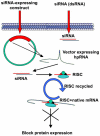Concepts in in vivo siRNA delivery for cancer therapy
- PMID: 19391103
- PMCID: PMC2692765
- DOI: 10.1002/jcp.21790
Concepts in in vivo siRNA delivery for cancer therapy
Abstract
In vivo gene silencing using RNAi plays an important role in target validation and is advancing towards the development of RNAi-based therapeutics. RNAs were thought to have just two broad functions in cells as messenger RNAs (mRNAs) and ribosomal RNAs, but recently the relevance of microRNAs is becoming more clearly understood. mRNA molecules transmit information between DNA and protein and, as such, are vital intermediaries for gene expression. Ribosomal and transfer RNAs have structural, catalytic, and information-decoding roles in the process of protein synthesis, whereas microRNAs are regulators of gene expression. This review presents the early and intriguing successes of using siRNAs for in vivo gene silencing and its use as a possible cancer therapeutics.
Figures


Similar articles
-
Noncoding RNA for Cancer Gene Therapy.Recent Results Cancer Res. 2016;209:51-60. doi: 10.1007/978-3-319-42934-2_4. Recent Results Cancer Res. 2016. PMID: 28101687 Free PMC article. Review.
-
Polyethylenimines for siRNA and miRNA delivery in vivo.Wiley Interdiscip Rev Nanomed Nanobiotechnol. 2013 Sep-Oct;5(5):484-501. doi: 10.1002/wnan.1228. Epub 2013 May 29. Wiley Interdiscip Rev Nanomed Nanobiotechnol. 2013. PMID: 23720168 Review.
-
Molecular mechanisms of RNA-triggered gene silencing machineries.Acc Chem Res. 2012 Jul 17;45(7):1122-31. doi: 10.1021/ar200253u. Epub 2012 Feb 3. Acc Chem Res. 2012. PMID: 22304792 Free PMC article.
-
Lipid nanoparticles for short interfering RNA delivery.Adv Genet. 2014;88:71-110. doi: 10.1016/B978-0-12-800148-6.00004-3. Adv Genet. 2014. PMID: 25409604 Free PMC article. Review.
-
Applications of RNA interference in cancer therapeutics as a powerful tool for suppressing gene expression.Mol Biol Rep. 2009 Nov;36(8):2153-63. doi: 10.1007/s11033-008-9429-7. Epub 2009 Jan 1. Mol Biol Rep. 2009. PMID: 19117119 Review.
Cited by
-
Genomic screening with RNAi: results and challenges.Annu Rev Biochem. 2010;79:37-64. doi: 10.1146/annurev-biochem-060408-092949. Annu Rev Biochem. 2010. PMID: 20367032 Free PMC article. Review.
-
Matrix metalloproteinase and G protein coupled receptors: co-conspirators in the pathogenesis of autoimmune disease and cancer.J Autoimmun. 2009 Nov-Dec;33(3-4):214-21. doi: 10.1016/j.jaut.2009.09.011. Epub 2009 Oct 1. J Autoimmun. 2009. PMID: 19800199 Free PMC article. Review.
-
ROS-Responsive Biomimetic Nanocomplexes of Liposomes and Macrophage-Derived Exosomes for Combination Breast Cancer Therapy.Int J Nanomedicine. 2025 Apr 24;20:5161-5180. doi: 10.2147/IJN.S514375. eCollection 2025. Int J Nanomedicine. 2025. PMID: 40297405 Free PMC article.
-
Emerging therapeutic biomarkers in endometrial cancer.Biomed Res Int. 2013;2013:130362. doi: 10.1155/2013/130362. Epub 2013 Jun 11. Biomed Res Int. 2013. PMID: 23819113 Free PMC article. Review.
-
A rat model of intravesical delivery of small interfering RNA for studying urinary carcinoma.World J Urol. 2010 Aug;28(4):479-85. doi: 10.1007/s00345-010-0542-6. Epub 2010 Apr 8. World J Urol. 2010. PMID: 20376453
References
-
- Aigner A. Gene silencing through RNA interference (RNAi) in vivo: strategies based on the direct application of siRNAs. J Biotechnol. 2006;124:12–25. - PubMed
-
- Aigner A. Cellular delivery in vivo of siRNA-based therapeutics. Curr Pharm Des. 2008;14:3603–3619. - PubMed
-
- Alshamsan A, Haddadi A, Incani V, Samuel J, Lavasanifar A, Uludag H. Formulation and Delivery of siRNA by Oleic Acid and Stearic Acid Modified Polyethylenimine. Mol Pharm. 2009;6:121–133. - PubMed
-
- Apirion D. The fate of mRNA and rRNA in Escherichia coli. Brookhaven Symp Biol. 1975:286–306. - PubMed
-
- Berns K, Hijmans EM, Mullenders J, Brummelkamp TR, Velds A, Heimerikx M, Kerkhoven RM, Madiredjo M, Nijkamp W, Weigelt B, Agami R, Ge W, Cavet G, Linsley PS, Beijersbergen RL, Bernards R. A large-scale RNAi screen in human cells identifies new components of the p53 pathway. Nature. 2004;428:431–437. - PubMed
Publication types
MeSH terms
Substances
Grants and funding
- R01 NS061835/NS/NINDS NIH HHS/United States
- NS47699/NS/NINDS NIH HHS/United States
- R01 NS057529/NS/NINDS NIH HHS/United States
- CA95058/CA/NCI NIH HHS/United States
- R01 CA116708/CA/NCI NIH HHS/United States
- R01 NS047699/NS/NINDS NIH HHS/United States
- R01 CA095058/CA/NCI NIH HHS/United States
- R01 CA092393/CA/NCI NIH HHS/United States
- CA92393/CA/NCI NIH HHS/United States
- NS61835/NS/NINDS NIH HHS/United States
- R01 CA075557/CA/NCI NIH HHS/United States
- CA75557/CA/NCI NIH HHS/United States
- NS57529/NS/NINDS NIH HHS/United States
- CA116708/CA/NCI NIH HHS/United States
LinkOut - more resources
Full Text Sources
Other Literature Sources
Medical

